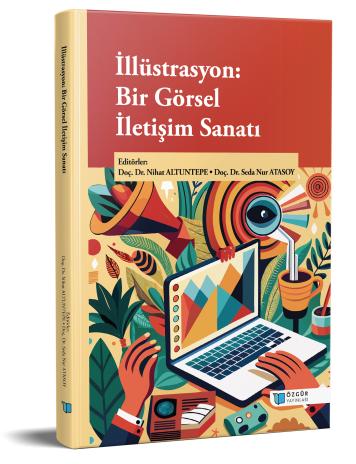
İllüstrasyon: Bir Görsel İletişim Sanatı
İndir
Özet
Basitçe, bir iletinin, görsel olarak aktarılması, bir metnin açıklanması amacıyla yapılan resimleme çalışması anlamına gelen “illüstrasyon” sözcüğünün kökeni, Latince “aydınlatmak” anlamına gelen “illustrare” sözcüğüdür. İllüstrasyon olgusu eski çağlarda var olmuş olsa da sözcüğe kaynaklık eden eserler Orta Çağda ortaya çıkan inanç odaklı el yazması kitaplardaki altın boya ve parlak renklerle çalışılmış resim ve süsleme çalışmalarıdır. Bu eserlerin yansımaları Osmanlı minyatürlerinde de görülebilirken illüstrasyon, Johannes Gutenberg’in geliştirdiği matbaa ve sonraki dönemlerde ortaya çıkan basım teknolojileriyle sürekli olarak değişerek daha çok insana ulaşabilen bir görsel iletişim dalı olmaya devam etmiştir.
Gülmece odaklı, iğneleyici, sert, duygusal, göndermeler içeren, büyüleyici, siyaset odaklı, eğlence odaklı ve benzeri birçok yaklaşımla yaratılabilen illüstrasyon çalışmaları, kitap, dergi, ambalaj, afiş, canlandırma filmleri, kutu ve video oyunları, müze ve benzeri kültürel alanlar, bilimsel yayınlar gibi birçok ortamda açıklama, bilgilendirme, eğlendirme, süsleme, konuları yorumlama, izleyeni kışkırtma, ilgi çekme, öykü anlatma amacıyla kullanılır. Metin ve iletilerin birebir yansıması olmanın ötesine geçerek, onlarla farklılıklar, çelişkiler, zıtlıklar içeren illüstrasyonlar, anlamın derinleşerek pekişmesini sağlayabilirler. Bazı durumlarda, illüstrasyon bir görsel iletişim biçimi, anlatım sorunlarına çözüm üretme yöntemi, bir kayıt tutma ve bir tür gazetecilik aracı olarak işlev görebilir. Bazen, ticari bağlamda çalışılan uygulamalı bir sanat dalı ya da eğlence piyasası içerisinde kişisel ifade biçimlerine olanak sağlayan bir iletişim yöntemi olarak da yorumlanabilir. Grafik Tasarım dalı içerisinde görüntü oluşturma yoluyla kompozisyon oluşturan, tasarımı tamamlayıcı bir öge olarak da değerlendirilebilir. İllüstrasyon birçok farklı dalda, çeşitli ifade biçimlerine olanak sağlar.
İllüstratörler, anlam üreten, iletileri belirli bir hedef kitleye aktarma görevini üstlenen görsel iletişimcilerdir. Çalışmalarını yaratma süreçlerinin temelinde, illüstratörün kişisel biçemi, yaratıcı görseller üretme isteği, duygu ve düşünceleri görsellere dönüştürme becerisi yatar. Metin ve görseller, birbirini güçlendirebilen iki ifade biçimidir ve illüstratörler, sözcükler ve resimler arasındaki etkileşimi en etkili biçimde kullanmak durumundadırlar. Çalışmaları yoluyla, “bir resim bin sözcüğe bedeldir” deyimini haklı çıkarırlar.
21. Yüzyılda illüstrasyon yenilenmeye, evrilerek gelişmeye devam etmektedir. Çatısı altında sayılabileceği Grafik Tasarım alanının tüm dalları gibi, üretim teknolojilerine ve teknolojileri kullanan yeni nesillere bağlı olan illüstrasyon, metinlere hizmet etmenin ötesine geçerek kendi ileti ve anlamlarını dijital araç ve teknolojilerin desteğiyle yaratmaktadır. Köklü bir geçmişi olan çağdaş anlatım ve iletişim aracı illüstrasyonu ilginç kılan özelliklerin başında, iletişim görevini yerine getirirken hayal gücü, yaratıcılık ve becerinin bir araya gelmesi yoluyla görsel öyküler anlatması ve yeni dünyalar yaratması gelir. Bu kitapta, illüstrasyonun zengin dünyası derinlemesine incelenecek olup metin ve görsel arasındaki karmaşık ilişkinin farklı yönleri, değerli yazarların özenli araştırmaları sonucu hazırladıkları bölümler yoluyla keşfedilecektir. Kitap, geniş bir kuramsal alt yapı ve bakış açısı yelpazesi sunar. İllüstrasyonun, konsept tasarımı, dijital sergileme tasarımı, fantastik illüstrasyon, süpergrafikler, müze deneyimi, bilimsel illüstrasyonlar, bilgi grafikleri, kutu oyunları, “kötü” kavramı ve dijital oyunlarla ilişkili olarak ele alındığı yayının, bilgilendirici, ilgi çekici ve ileride alanla ilgilenen başkalarının yapacağı araştırmalar için yardımcı bir kaynak olması umulmaktadır.

